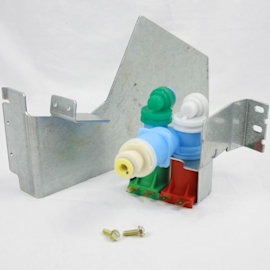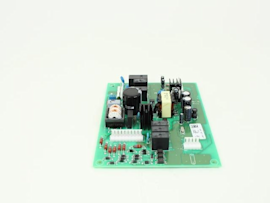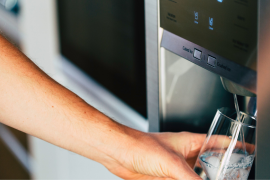- Kenmore refrigerator water filters
- Whirlpool refrigerator water filters
- Samsung refrigerator water filters
- GE refrigerator water filters
- LG refrigerator water filters
- Frigidaire refrigerator water filters
- KitchenAid refrigerator water filters
- Maytag refrigerator water filters
- Kenmore Elite refrigerator water filters
- Estate refrigerator water filters
- GE Profile refrigerator water filters
- Amana refrigerator water filters
- Bosch refrigerator water filters
- Dacor refrigerator water filters
- Electrolux refrigerator water filters
What are the main parts of a refrigerator?


Most refrigerator parts have 2 main functions—cooling and storage. Cooling parts include the control components and the parts in the sealed refrigerant system such as the compressor, evaporator, condenser and fans. Storage components include shelves, drawers and the door bins.
Many refrigerators have ice makers and dispenser systems. These systems make it convenient for you to get ice cubes and water from the door of the fridge.
Read on to learn more information about the main parts of a refrigerator.
Refrigerator cooling and control parts
The refrigerator control allows you to select the temperature inside the freezer and refrigerator section then monitors and maintains the set temperatures. The sealed refrigerant system continuously repeats these steps to cool the refrigerator:
The compressor compresses low-pressure refrigerant gas into hot, high-pressure gas which moves into the condenser.
The condenser cools down the hot refrigerant gas—condensing it into high-pressure liquid refrigerant.
The liquid refrigerant nest passes through a capillary tube. The capillary tube converts the liquid refrigerant into a refrigerant mist that enters the evaporator.
Positioned inside the freezer section of the fridge, the evaporator is a low pressure. The high-pressure refrigerant expands and evaporates. It absorbs the latent heat of vaporization as it changes from a liquid to a gas, which causes the cooling action in the evaporator. The low pressure gas leaves the evaporator and flows back to the compressor where the cycles starts over.
Frost builds up on the evaporator and inhibits the cooling process. Almost all refrigerators use an automatic defrost system to melt frost off the evaporator fins every 8 hours or when needed to keep the evaporator cooling air inside the refrigerator efficiently.
When the refrigerator isn’t cooling properly, you’ll need to diagnose the failure to determine which part to replace. Here’s a video that illustrates how to diagnose a cooling failure in a common top-mount refrigerator:
Here or definitions of the parts you’ll find in the control and cooling systems of refrigerators:
Compressor
The compressor is a positive displacement pump rotated by an electric motor. The compressor receives low-pressure refrigerant gas from the evaporator and rotates to compress that refrigerant to a high-pressure gas that moves through the condenser.
Compressor Start Relay
The compressor start relay starts the compressor and shuts off the compressor if the motor overheats. Replace the start relay if it's defective. View our How to Replace a Refrigerator Compressor Start Relay video to see how to replace this part when it’s defective.
Overload/PTC relay
The overload/PTC relay starts the compressor motor. It has 2 components: an overload protector that trips when the compressor motor overheats or locks up, and a relay. The relay completes the circuits to both the Start Windings and the Run Windings in the compressor motor. Once the motor is started, the relay de-energizes the Start Winding circuit so the compressor motor continues to run using just the run windings.
Condenser
The condenser contains heat-exchanging coils that cool down the hot refrigerant leaving the compressor.
Condenser fan
The condenser fan is in the machine compartment of the refrigerator next to the compressor. It moves air across the condenser coils to help cool the hot refrigerant coming out of the compressor. The refrigerant is cooled before it moves through the expansion device and into the evaporator.
Evaporator
The evaporator is the heat exchanger that provides the cooling for the refrigerator. This is accomplished with the help of low pressure liquid refrigerant that moves through the evaporator. The evaporator is kept at low pressure so that the liquid refrigerant evaporates and turns to vapor. The latent heat of vaporization is absorbed from the air that is blown across the metal fins in the evaporator. The air is cooled down as it blows across the metal fins which produces the refrigeration cooling process.
Evaporator fan
The evaporator fan is mounted on the evaporator assembly. It moves air across the evaporator fins and through the refrigerator cabinet for cooling.
Evaporator drip tray
The evaporator drip tray is a metal collection pan under the refrigerator evaporator. Sometimes referred to as an evaporator drip pan, it collects water that drips from the evaporator fins during the defrost cycle. The collected condensate water drains from evaporator drip tray through a drip tube to a drain pan at the bottom of the refrigerator in the machine compartment next to the compressor. The heat and air flow evaporates the condensate from the drain pan before the next defrost cycle begins.
Defrost timer
The defrost timer is an electro-mechanical timer that controls the intervals between automatic defrost cycles in the refrigerator. The defrost timer motor runs and moves the components in the device. When the contacts for the defrost cycle are engaged, the compressor stops and the defrost heater turns on briefly to melt frost from the evaporator fins. Removing the frost promotes a more efficient exchange of heat across that component. When the fins are defrosted, the contacts disengage, allowing normal cooling in the refrigerator.
Temperature control thermostat
The temperature control thermostat is mounted in the control housing area and controls the temperature inside the refrigerator. It turns on and shuts off the compressor as needed to maintain the set temperature in the refrigerator. The thermostat has a temperature sensor tube that detects the actual temperature in the refrigerator compartment and controls the temperature based on the reading from that sensor.
Refrigerator electronic control board
The refrigerator electronic control board controls the major electro-mechanical components in the refrigerator. When the electronic control board senses the compressor needs to run to cool the refrigerator, it sends voltage to the compressor and fans. It then receives input from temperature sensors to monitor the temperatures inside the refrigerator and freezer sections. With this information, the electronic control board controls the defrost cycle.
Thermistor
The thermistor is a temperature sensor within the refrigerator that sends information to the electronic control board.
Defrost Heater
The refrigerator defrost heater melts frost from the freezer’s evaporator fins. Replace the defrost heater if it doesn't heat when activated.
Defrost sensor
The defrost sensor—also known as the defrost bi-metal thermostat—shuts off the refrigerator defrost heater if the heater gets hot enough to damage the evaporator.
Defrost control assembly
This component has the defrost thermistor (temperature sensor) and the thermal fuse for the defrost heating element. The thermistor monitors the temperature of the evaporator during the automatic defrost process. Once the thermistor detects that the frost is all melted off of the evaporator, the heating element shuts off. If the sensor malfunctions and the evaporator begins to overheat, the fuse cuts off electrical power to the heater to protect the evaporator from damage.
Defrost Thermistor
The defrost thermistor attaches to the evaporator coil and measures the evaporator coil temperature during defrost.
Defrost drain tube
As part of the defrost cycle, the defrost drain tube transfers condensate that collects in the evaporator drip tray under the evaporator to the drain pan near the compressor, where the water evaporates.
Defrost drain pan
The drain pan collects condensate water from the defrost cycle. It's located in the machine compartment of the refrigerator, next to the compressor. The defrost system melts frost and ice from the evaporator fins about every 8 hours to increase the efficiency of the evaporator heat exchanger. The condensate water that drips from the evaporator during that process collects in the evaporator drip tray and then is routed to the drain pan through a drain tube. The drain pan collects the condensate, which is evaporated by the heat and air flow in the machine compartment before the next defrost cycle begins.
Defrost drain heat probe
The defrost drain probe device is an extension of metal attached to the bottom of the defrost heater in the refrigerator. The metal extension tab extends to the opening of the evaporator drip tray where the defrost drain tube is attached. It transmits warmth from the defrost heater to the area near the defrost drain tube area to prevent freezing. If that area of the evaporator drip tray does freeze, the path becomes clogged, preventing condensate water from flowing down the drain tube to the defrost drain pan.
Refrigerator storage parts
Storage components hold and help organize items inside the refrigerator and freezer. Storage parts include shelves, drawers and refrigerator door bins. Sears PartsDirect has replacement storage parts for all brands and types of refrigerators. To find a replacement storage part that fits your fridge, key the refrigerator model number in the search bar at the top of the page then find the part you need on the parts list diagram.
Ice maker and dispenser parts
It’s frustrating when your ice maker or dispenser stops working. When your ice maker or dispenser give out on you, try using the tips in our How to prevent water dispenser and ice maker problems article to fix the problem.
If you’re not able to fix the problem using those tips, then you may need to replace one of these parts:
Ice maker
The ice maker is a complete assembly that contains the ice mold and the control device. It plugs into a wire harness in the freezer or the ice compartment. The ice maker receives water from the inlet water valve and then holds the water in the ice mold until the water is frozen solid. It then automatically ejects the ice and refills to continue the process until the ice storage bucket is detected as full.
Water inlet valve
The water flow into the refrigerator is controlled by an electrically operated water inlet valve, which is usually located in the machine compartment at the bottom, back of the refrigerator. This valve has a coil that opens the valve and allows water to flow into the refrigerator water system when the valve is open. When voltage is shut off to the valve, the valve closes and prevents water from flowing into the water system in the refrigerator.
Water filter
The refrigerator water filter is installed in the filter housing and has carbon and/or other filter materials inside. It removes most sediment and other impurities from the water supplied to the refrigerator. Manufacturers recommend replacing the water filter every 6 months or when the water filter replacement reminder on your control turns on.
Dispenser control board
The dispenser control board activates the water and ice dispenser components to dispense ice or water when you press the activation pads on the freezer door. The dispenser control board also shuts off the dispenser functions when you open the freezer door in side-by-side refrigerators or a refrigerator door in French-door fridges.
Ice dispenser motor
The ice dispenser motor spins the auger that pushes ice through the dispenser door when you press the ice dispenser lever.
Refrigerators also have many other parts such as door switches and lights. Gaskets and seals inside the refrigerator help keep cold air in and warm out of the fridge. You can order any of these parts from our Sears PartsDirect website. To get the right part for your model, look up the replacement part using the model number of your refrigerator.
Many of the parts in the sealed cooling system such as the compressor, condenser and evaporator should only be replaced by a service technician because the repair involves recovering and recharging refrigerant in the sealed refrigerant system. You should also have a service technician diagnose and repair any refrigerator problem that you aren’t able to fix yourself or that you don’t feel confident that you can safely repair yourself.
To keep your refrigerator in top shape, schedule Cleaning and Maintenance Service annually. Regular maintenance of your refrigerator can help prevent costly breakdowns and extend the life of your fridge.
Most common symptoms to help you fix your refrigerators
Choose a symptom to see related refrigerator repairs.
Main causes: control board or cold control failure, broken compressor start relay, compressor motor failure, defrost tim…
Main causes: jammed ice cubes, broken ice maker assembly, dirty water filter, kinked water line, bad water valve, freeze…
Main causes: water valve leaking, frozen or broken defrost drain tube, overflowing drain pan, cracked water system tubin…
Main causes: damaged door seal, faulty defrost sensor or bi-metal thermostat, broken defrost heater, bad defrost timer o…
Main causes: blocked vents, defrost system problems, evaporator fan failure, dirty condenser coils, bad sensors, condens…
Main causes: blocked air vents, compressor problems, condenser or evaporator fan not working, control system failure, se…
Main causes: leaky door gasket, defrost system failure, evaporator fan not running, dirty condenser coils, condenser fan…
Things to do: clean condenser coils, replace the water filter, clean the interior, adjust doors to prevent air leaks, cl…
Most common repair guides to help fix your refrigerators
These step-by-step repair guides will help you safely fix what’s broken on your refrigerator.

How to replace a refrigerator water valve
Replace the water valve that feeds water to the ice maker and water dispenser if it no longer controls the flow of water…
Repair difficulty
Time required
15 minutes or less

How to clean refrigerator condenser coils
Help your refrigerator run more efficiently by cleaning the condenser coils. It's easy and takes just a few minutes.…
Repair difficulty
Time required
15 minutes or less

How to replace a refrigerator temperature control board
If the temperature in your refrigerator doesn't match the temperature you set, the problem could be the temperature cont…
Repair difficulty
Time required
30 minutes or less
Effective articles & videos to help repair your refrigerators
Use the advice and tips in these articles and videos to get the most out of your refrigerator.

No matter what style Maytag refrigerator you have, we can walk you through replacing the water filter.…

Learn about all the convenient features on our Sears PartsDirect website that make your parts purchases easier.…

Get tips and advice on replacing the water filter in your LG refrigerator.…